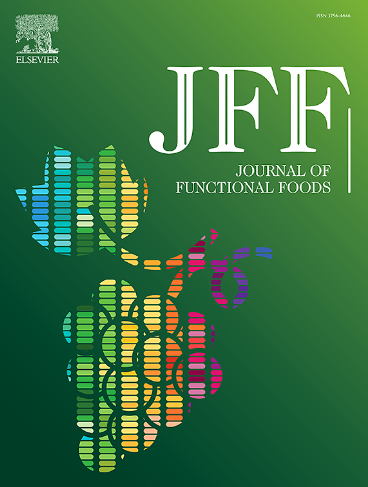Integrated lipid metabolomics and network pharmacology to investigate the potential mechanism of Coix seed in alleviating ulcerative colitis
IF 3.8
2区 农林科学
Q2 FOOD SCIENCE & TECHNOLOGY
引用次数: 0
Abstract
Coix seed (CS), an agricultural crop often eaten as a staple food, has been used as a functional food treating ulcerative colitis (UC) recently. However, the underlying mechanism of CS on treating UC remains unclear. This study innovatively explored the preventive effects of CS on dextran sulfate sodium (DSS)-induced colitis in mice and its underlying mechanisms using lipid metabolomics and network pharmacology analysis. The results demonstrated that CS significantly reduced body weight loss, DAI scores, colonic damage and pro-inflammatory cytokines levels, such as TNF-α and IL-6, in UC mice. Additionally, CS reversed the DSS-induced downregulation of tight junction proteins, including ZO-1 and Occludin. Lipidomics results indicated a significant difference in lipid status between the normal and UC mice, which was reduced following CS treatment. Notably, levels of phosphatidylethanolamine (PE) and sphingomyelin (SM) were the most significantly altered lipids in UC mice after CS treatment. Furthermore, network pharmacology analysis indicated SRC, PPARG, PTGS2, MAPK1, MAPK3 and ESR1 as key targets for CS in alleviating UC inflammation. The enrichment analysis revealed that CS targeted functional modules associated with MAPK signaling and lipid metabolism. Further experimental validation, molecular docking and molecular dynamics simulation demonstrated that CS exerts significant protective effects through the Src/JNK MAPK and Nrf2/PPARγ signaling pathways. Overall, this study elucidated the potential of CS as a treatment for UC by regulating the lipid metabolism, which may be related to the Src/JNK MAPK and Nrf2/PPARγ signaling pathways. This strategy provides an important support for the utilization and development of CS as a functional food in human wellness, especially in ameliorating UC.

结合脂质代谢组学和网络药理学研究薏苡仁缓解溃疡性结肠炎的潜在机制
薏苡仁(CS)是一种经常作为主食食用的农作物,最近被用作治疗溃疡性结肠炎(UC)的功能性食品。然而,薏苡仁治疗溃疡性结肠炎的内在机制仍不清楚。本研究采用脂质代谢组学和网络药理学分析方法,创新性地探讨了CS对葡聚糖硫酸钠(DSS)诱导的小鼠结肠炎的预防作用及其内在机制。结果表明,希尔思能明显减轻 UC 小鼠的体重下降、DAI 评分、结肠损伤和促炎细胞因子水平,如 TNF-α 和 IL-6。此外,CS还逆转了DSS诱导的ZO-1和Occludin等紧密连接蛋白的下调。脂质组学研究结果表明,正常小鼠和 UC 小鼠的脂质状况存在显著差异,而 CS 治疗后这种差异有所缩小。值得注意的是,CS治疗后,UC小鼠磷脂酰乙醇胺(PE)和鞘磷脂(SM)水平的变化最为显著。此外,网络药理学分析表明,SRC、PPARG、PTGS2、MAPK1、MAPK3 和 ESR1 是 CS 缓解 UC 炎症的关键靶点。富集分析表明,CS靶向的功能模块与MAPK信号转导和脂质代谢有关。进一步的实验验证、分子对接和分子动力学模拟表明,CS 可通过 Src/JNK MAPK 和 Nrf2/PPARγ 信号通路发挥显著的保护作用。总之,本研究阐明了 CS 通过调节脂质代谢治疗 UC 的潜力,而脂质代谢可能与 Src/JNK MAPK 和 Nrf2/PPARγ 信号通路有关。这一策略为利用和开发 CS 作为人类健康的功能性食品提供了重要支持,尤其是在改善 UC 方面。
本文章由计算机程序翻译,如有差异,请以英文原文为准。
求助全文
约1分钟内获得全文
求助全文
来源期刊

Journal of Functional Foods
FOOD SCIENCE & TECHNOLOGY-
CiteScore
9.60
自引率
1.80%
发文量
428
审稿时长
76 days
期刊介绍:
Journal of Functional Foods continues with the same aims and scope, editorial team, submission system and rigorous peer review. We give authors the possibility to publish their top-quality papers in a well-established leading journal in the food and nutrition fields. The Journal will keep its rigorous criteria to screen high impact research addressing relevant scientific topics and performed by sound methodologies.
The Journal of Functional Foods aims to bring together the results of fundamental and applied research into healthy foods and biologically active food ingredients.
The Journal is centered in the specific area at the boundaries among food technology, nutrition and health welcoming papers having a good interdisciplinary approach. The Journal will cover the fields of plant bioactives; dietary fibre, probiotics; functional lipids; bioactive peptides; vitamins, minerals and botanicals and other dietary supplements. Nutritional and technological aspects related to the development of functional foods and beverages are of core interest to the journal. Experimental works dealing with food digestion, bioavailability of food bioactives and on the mechanisms by which foods and their components are able to modulate physiological parameters connected with disease prevention are of particular interest as well as those dealing with personalized nutrition and nutritional needs in pathological subjects.
 求助内容:
求助内容: 应助结果提醒方式:
应助结果提醒方式:


